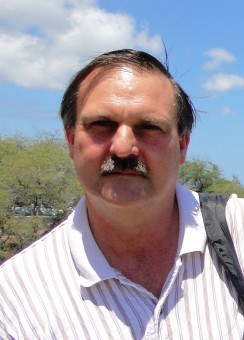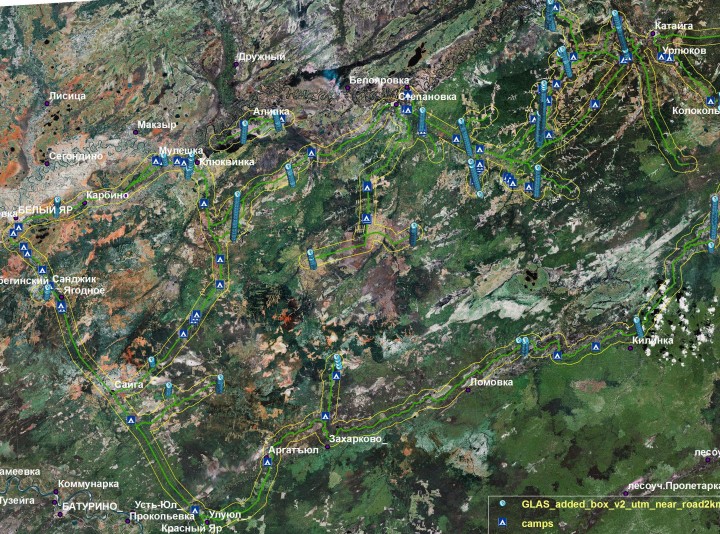

Tomsk Oblast 57.45 N 85.96 E
11:30 pm Siberia, 11:30 am EST
High: 60 F Low 62 F Light rain
It’s been quite a long day on the road. We spent about 11 hours today working our way about 700 km through the countryside to find this campsite. We got in as the sun was going down. We scrambled to pitch tends, and then most of us went right off to bed. It’s just me and the mosquitoes. I think they are happy to have my company.
We had a little trouble with loading the vehicles. We have a lot of stuff we’re taking with us. We got everything stowed securely then we realized we’d made a big mistake – there wasn’t enough room for all the people. Something had to go. For awhile it seemed to be a question of if they would keep the inflatable boat or me. I’m happy to report that they picked me, and we left the boat behind. It’s a loss, though – it means we won’t be able to reach the more remote sites.

Krasnoyarsk, Siberia 56.2° N 92.5°E
10:20 PM Siberia; 10:20 AM next day EST
Temp: High: 62°F Low: 41°F Wind: light Some fog
Hello from Siberia! We’ve finally arrived safely and happily in Krasnoyarsk. Weather is good here. It’s slightly cool and rainy, without any sign of the smoke and foul air that we’ve heard about from the fires near Moscow. Apparently western Siberia has escaped the summer’s terrible heat, the drought and the fires that are burning in the west of Russia. Slava tells me there has been plenty of rain in the past month and lots of cool weather. So summer is Krasnoyarsk is unchanged from past years, and I’m glad for that.

 Dr. Jon Ranson is an earth scientist specializing in radar, lidar and remote sensing. As NASA Goddard Space Flight Center DESDynI Lidar Project Scientist and Head of the NASA GFSC Biospheric Sciences Branch in Greenbelt, Maryland, he uses these tools for studying vegetation type and biomass in ecosystem research. Under his guidance the Branch is advancing the use of satellite technology to study the carbon cycle and ecosystem science. Dr. Ranson has participated in numerous field campaigns in the United States, Canada and Siberia to improve our ability to measure and monitor vegetated ecosystems from space. He enjoys hiking, birding, music and outdoor cooking.
Dr. Jon Ranson is an earth scientist specializing in radar, lidar and remote sensing. As NASA Goddard Space Flight Center DESDynI Lidar Project Scientist and Head of the NASA GFSC Biospheric Sciences Branch in Greenbelt, Maryland, he uses these tools for studying vegetation type and biomass in ecosystem research. Under his guidance the Branch is advancing the use of satellite technology to study the carbon cycle and ecosystem science. Dr. Ranson has participated in numerous field campaigns in the United States, Canada and Siberia to improve our ability to measure and monitor vegetated ecosystems from space. He enjoys hiking, birding, music and outdoor cooking.
Read more

Western Siberia is, in places, remote. However, much of the region can be accessed by a system of roads and rivers. When planning this expedition, the scientists needed to find the location of GLAS footprints – measurements taken by the Geoscience Laser Altimeter System aboard the ICESat Satellite – in the area as well as find routes to enter those footprints. The goal of the expedition is to measure by hand, on location, as many GLAS footprints as possible in the study area. This is called ground-truth validation, and is an essential part of understanding data acquired by remote sensing instruments.
Read more
An international team of scientists, led by Dr. Jon Ranson, Head of the Biospheric Sciences Branch at NASA’s Goddard Space Flight Center and Dr. Slava Kharuk of the Sukachev Forest Institute are heading to Siberia this August to study the regions forests. They will work in austere conditions to collect data related to the Earth’s carbon budget, and to document the effects of climate change in the region.